|
|
|
Introduction of
Gwalior |
|
Gwalior
City is a District in Madhya Pradesh State near Âgra. The new section
of the city called Lashkar. Lashkar is few miles South from the old
city. It is the site of factories producing cotton, yarn, paint,
ceramics, chemicals, and leather products. The nucleus of Gwalior is a
citadel crowning an isolated rock about 91 m (300 ft) high, 3.2 km (2
mi) long, and 823 m (2700 ft) wide. The rock is said to have been a
strong hold for more than Ten Centuries and Old city is located in the
Eastern base of the rock. The old city is covered with white sandstone
Mosque, Palaces, rock temples and statues of archaeological and
architectural interest. The Jiwaji University was built in Gwalior in
the year 1964. Gwalior City was the Capital of the princely State of
Gwalior until 1948 and the summer Capital of Madhya Bharat State from
1948 to 1956. When Madhya Bharat became part of Madhya Pradesh, it
become separate District. |
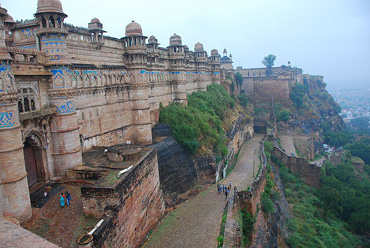
Gwalior Fort |
|
Gwalior's
history is traced back to a legend in 8th century AD when a chief tain
known as Suraj Sen was struck by a deadly disease and cured by a
hermit-saint Gwalipa. As a gratitude for that incidence, he founded
this city by his name. The new city of Gwalior became existance over
the centuries. The cradle of great dynasties ruled the city Gwalior.
With different Dynasty, the city gained a new dimension from the
warrior kings, poets, musicians, and saints who contributed to making
it renowned throughout the country. The city is also the setting for
the memorials of freedom fighters such as Tatya Tope and the
indomitable Rani of Jhansi. Today the old settings stand side by side
with the trappings of modernity. |
|
|
|
History of Gwalior |
|
According to a legend, Gwalior derives
its name from a great sage Gwalipa who cured a chief of the Kachwaha
clan suffering from leprosy.
Gwalior's strategic position between north and south India made it an
important possession and was captured by several ruling houses. The
first historical holders of the city were the Huns. Between 11th to
14th century AD, Gwalior came under the influence of Kachwaha Rajputs,
the Pratiharas, Qutub-ud-din Aibak, and Iltutmish, and remained under
Muslim possession until 1398. Under the Tomars, whose most important
king was Man Singh (1486-1517), Gwalior rose to prominence. Gwalior
was finally surrendered to Ibrahim Lodhi in 1518. Held in succession
by the Mughals, Jats, Marathas and the British, Gwalior was finally
handed over to Jiyaji Rao Scindia at a formal durbar in 1885. The
Scindias were the last ruling family of Gwalior and are still
influential in the political arena of India.
Today, the city is also famous for the educational institutions like
Indian Institute of Information Technology and Management, Indian
Institute of Travel and Tourism Management, Scindia School, and
Laxmibai National Institute of Physical Education attracting students
from every nook and corner of the country. |
|
|
|
Tourist Attraction in Gwalior |
|
The Fort
Standing on a steep mass of sandstone, Gwalior Fort dominates the city
and is its most significant monument. It has been the scene of
momentous events, imprisonment, battles and jauhars. A steep road
winds upwards to the fort, flanked by statues of the Jain tirthankaras,
carved into the rock face. The magnificent outer walls of the fort
still stand, two miles in length and 35 feet high, bearing witness to
its reputation for being one of the most invincible forts of India.
This imposing structure inspired Emperor Babur to describe it as " the
pearl amongst the fortresses of Hind ".
Gujari Mahal
Within the fort are some marvels of medieval architecture. The 15th
century Gujari Mahal is a monument to the love of Raja Mansingh Tomar
for his intrepid Gujar Queen, Mrignayani. The outer structure of
Gujari Mahal has survived in an almost total state of preservation;
the interior has been converted into Archaeological Museum housing
rare antiquities,some of them dating back to the 1st century A.D. Even
though many of these have been defaced by the iconoclastic Mughals ,
their perfection of form has survived the ravages of time.
Particularly worth seeing is the statue of Shalbhanjika from Gyraspur,
the tree goddess, the epitome of perfection in miniature . The statue
is kept in the custody of the museum's curator, and can be seen on
request.
Man Mandir Palace
Man
Mandir Palace was constructed by Raja Mansingh between 1486 and 1517.
The tiles that once decorated its exterior have not survived, but the
traces of these tiles still remain at the entrance of the palace.
Vast
chambers with fine stone screens were once the music halls, and behind
these screens, the royal ladies would learn music from the great
masters of the day. Below, circular dungeons housed the state
prisoners of the Mughals. Emperor Aurangzeb had his brother , Murad
imprisoned , and later executed here. Close by is Jauhar Pond, where
in the Rajput tradition, the Ranis committed mass sati after their
consorts had been defeated in battle. At Man Mandir Palace, a poignant
ambience of those days of chivalry and heroism still lingers in the
silent chambers. A superbly mounted Son-et-Lumiere here brings it all
alive every evening.
Ghaus
Mohammed's Tomb
The sandstone mausoleum of the Afghan prince, Ghaus Mohammed, is also
designed on early Mughal lines. Particularly exquisite are the screens
which use the pierced stone technique as delicate as lace. It is on
the way to Gwalior fort near Hazira from Railway Station.
|
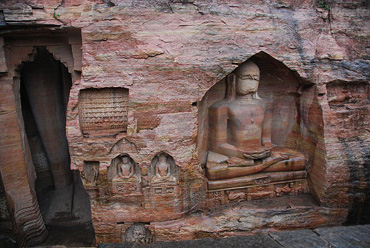 |
 |
|
Sculptures |
Gujari Mahal |
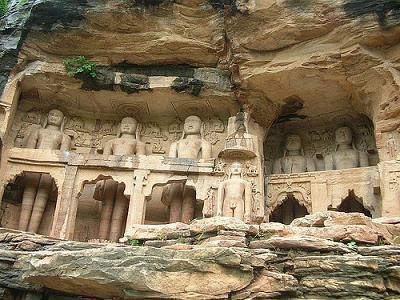 |
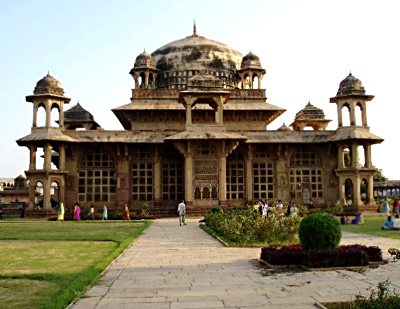 |
|
Gwalior Fort |
Ghaus Mohammed
Tomb |
 |
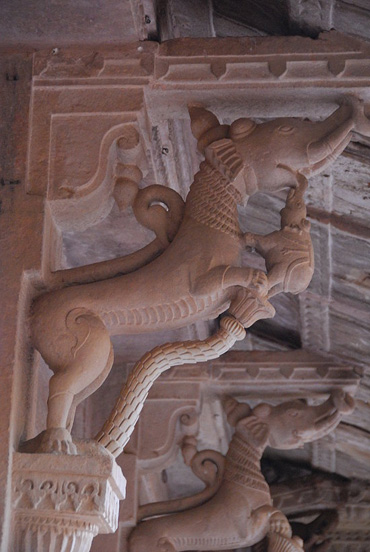 |
|
Gwalior Fort |
Gwalior Fort |
|
Gurudwara Data Bandhi Chhod
Built in the memory of Guru Hargobind Saheb , the 6th Sikh Guru who
was imprisoned here by Emperor Jehangir for over two years. It is
located on the Gwalior Fort.
Distance from Railway Station / Bus Stand : 6.00 Kms Approx.
Tomb of Tansen
This is the tomb of the father of Hindustani classical music, the
great Mian Tansen, one of the 'Nine Jewels' of Emperor Akbar's court.
It is built in the early Mughal architectural style and is surrounded
by lush gardens in typical Mughal style. There is a tamarind tree near
the tomb. It is believed that Tansen got fabulous voice after eating
leaves of this tree so people visiting the place also eat these
leaves.
Jai Vilas Palace and Museum
A splendor of a different kind exists in the Jai Vilas Palace, current
residence of the Scindia family. Some 25 rooms have been turned into
the Jivaji Rao Scindia Museum, and in these rooms , so evocative of a
regal lifestyle, that the past comes alive. Jai Vilas is an
Italianate structure which combines the Tuscan and Corinthian
architectural modes.
The imposing Darbar Hall has two central chandeliers weighing a couple
of tones, and hung only after ten elephants had tested the strength of
the roof. Ceilings picked out in gilt, heavy draperies and tapestries
, fine Persian carpets and antique furniture from France and Italy are
the features of these spacious rooms. |
|
|
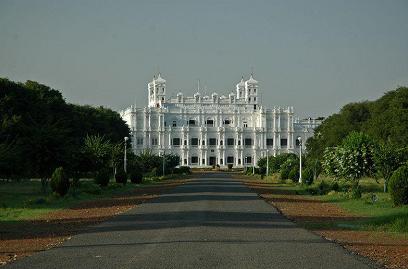 |
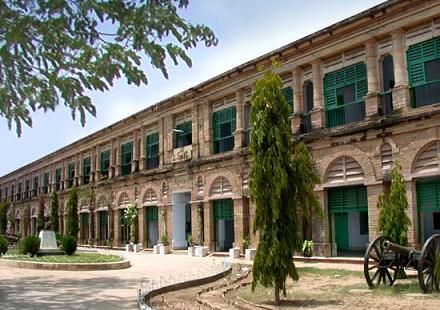 |
|
Jai Vilas
Palace |
Scindia
School |
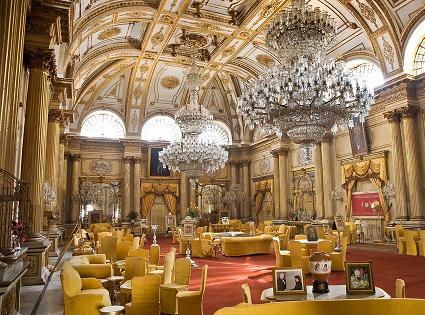 |
 |
|
Darbar Jai
Vilas Palace |
Teli Ka Mandir |
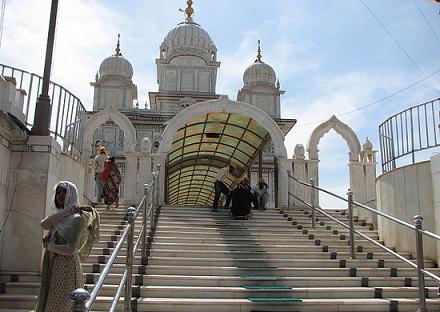 |
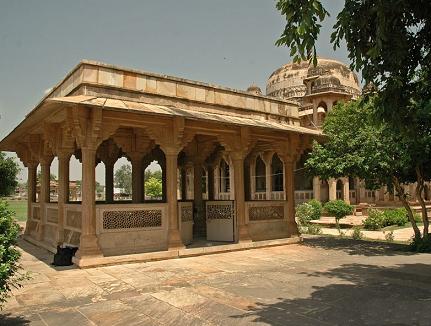 |
|
Gurudwara
Data Bandhi Chhod |
Tomb of
Tansen |
|
|
How to Reach Gwalior |
|
By Air
Gwalior is connected by Indian Airlines to Bombay, Bhopal, Indore,
and Delhi.
By Rail:
Gwalior is on the main Delhi-Bombay and Delhi-Madras rail link.
Among major trains, the Taj and Shatabdi Express connect Gwalior with
Delhi and Agra. Gwalior is well linked with Agra (118 km), Mathura,
Jaipur (350 km), Delhi (321 km), Lucknow, Bhopal (423 km), Chanderi
(239 km), Indore (486 km), Jhansi (101 km), Khajuraho (275 km), Ujjain
(455 km), and Shivpuri (114 km).
By Road:
The most common and cheapest way of moving around the city is the
six-seater auto-rickshaws. Taxis are also available so are mini buses. |
|
|
|
You will visit
“Gwalior”
during the below Tour of Rajasthan. |
|
 Delightful Rajasthan and North
India Tour (Group Tour) (Including Gwalior)
Delightful Rajasthan and North
India Tour (Group Tour) (Including Gwalior)

20 Days / 19 Nights
Delhi - Mandawa
- Bikaner - Jaisalmer - Osian - Jodhpur - Ranakpur - Udaipur - Pushkar
- Jaipur - Fatehpur Sikri - Agra - Gwalior - Orchha - Khajuraho -
Varanasi - Delhi |
|
|
|
|
|
|
|
|
|
|
|